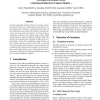Free Online Productivity Tools
i2Speak
i2Symbol
i2OCR
iTex2Img
iWeb2Print
iWeb2Shot
i2Type
iPdf2Split
iPdf2Merge
i2Bopomofo
i2Arabic
i2Style
i2Image
i2PDF
iLatex2Rtf
Sci2ools
118
click to vote
CVPR
1996
IEEE
1996
IEEE
Occlusion Detectable Stereo -- Occlusion Patterns in Camera Matrix
In stereo algorithms with more than two cameras, the improvement of accuracy is often reported since they are robust against noise. However, another important aspect of the polynocular stereo, that is the ability of occlusion detection, has been paid less attention. We intensively analyzed the occlusion in the camera matrix stereo (SEA) and developed a simple but effective method to detect the presence of occlusion and to eliminate its effect in the correspondence search. By considering several statistics on the occlusion and the accuracy in the SEA, we derived a few base masks which represent occlusion patterns and are effective for the detection of occlusion. Several experiments using typical indoor scenes showed quite good performance to obtain dense and accurate depth maps even at the occluding boundaries of objects.
Related Content
| Added | 07 Aug 2010 |
| Updated | 07 Aug 2010 |
| Type | Conference |
| Year | 1996 |
| Where | CVPR |
| Authors | Yuichi Nakamura, Tomohiko Matsuura, Kiyohide Satoh, Yuichi Ohta |
Comments (0)

